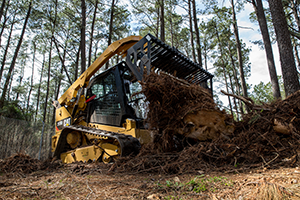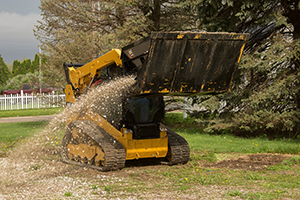
Caterpillar unveiled new skeleton and side discharge buckets.
The skeleton buckets are designed to separate rocks and large debris from soil and sand and can be used with skid-steer loaders, multiterrain loaders, compact track loaders and compact wheel loaders.
Heavy steel rods, 1.25 inches in diameter on 3.75-inch centers, form the floor and back of the bucket. Thick plates with rectangular openings form the sides of the bucket, and a rectangular frame is made of heavy-duty steel and incorporates two steel plate rock dams, which serve to retain material, reduce spillage and increase production, according to the company.
Steel gussets are welded between the outermost rods in the bucket floor and the sides of the bucket. The forward ends of the rods in the bucket floor are secured in a heavy-duty support beam positioned between (and welded to) the bucket sides, providing support and allowing the bucket to be used for grading.
Heavy steel tines are welded to the forward tips of the rods and support beam to enhance breakout force, Caterpillar said.

Caterpillar’s side discharge buckets—designed for use with skid-steer loaders, multiterrain loaders, compact track loaders and compact wheel loaders—collect and transport loose materials such as sawdust, sand, mulch and topsoil and discharge the materials via a belt-type conveyor from adjustable openings (doors) on either side of the bucket.
A rotating agitator works to keep material flowing to the conveyor. Adjusting the conveyor speed and door openings controls the volume of material discharged and the area covered.
The machine’s rubber conveyor belt—featuring a raised chevron tread design and equipped with an adjustable tensioning device—functions whether discharging material left or right.
Two externally mounted, reversible, hydraulic motors power the conveyor directly, eliminating intermediate drive mechanisms. Openings in the bucket floor allow any material remaining in the bucket to escape, preventing material buildup beneath the conveyor. The buckets also feature an internal baffle to reduce belt strain.
The agitator assembly is powered via a third, high-torque hydraulic motor to reduce material bridging in the bucket. Agitator paddles are available in sand and sawdust configurations, the sand style featuring a straight design that exerts added force to push through dense material, and the sawdust type featuring an aggressive design that uses prongs to assist in breaking up material and reducing weight on the conveyor, said the company.
The manually adjustable discharge doors, one on each side of the bucket, regulate the volume of material discharged. The doors are built with thick-plate reinforcing materials. A welded, serrated step facilitates entering and exiting the cab.

